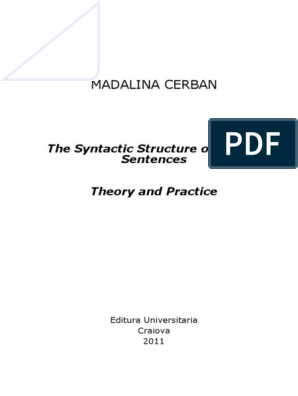0% found this document useful (0 votes)
28 views34 pagesStudents Lesson 3 Syntax Bsee23-1
Here are some common phrase structure symbols:
NP = Noun Phrase
AP = Adjective Phrase
AdvP = Adverb Phrase
PP = Prepositional Phrase
VP = Verb Phrase
These symbols are used to represent the syntactic categories or constituents in phrase structure rules.
| 34
BSEE 23: STRUCTURE OF ENGLISH
Uploaded by
maryzlucillemagnoCopyright
© © All Rights Reserved
We take content rights seriously. If you suspect this is your content, claim it here.
Available Formats
Download as PDF, TXT or read online on Scribd
0% found this document useful (0 votes)
28 views34 pagesStudents Lesson 3 Syntax Bsee23-1
Here are some common phrase structure symbols:
NP = Noun Phrase
AP = Adjective Phrase
AdvP = Adverb Phrase
PP = Prepositional Phrase
VP = Verb Phrase
These symbols are used to represent the syntactic categories or constituents in phrase structure rules.
| 34
BSEE 23: STRUCTURE OF ENGLISH
Uploaded by
maryzlucillemagnoCopyright
© © All Rights Reserved
We take content rights seriously. If you suspect this is your content, claim it here.
Available Formats
Download as PDF, TXT or read online on Scribd
/ 34

















































































